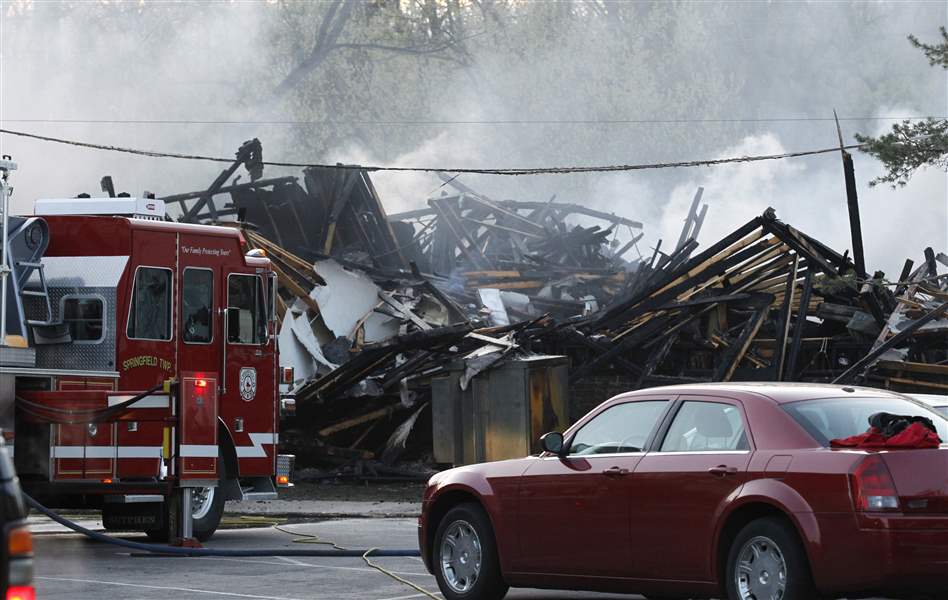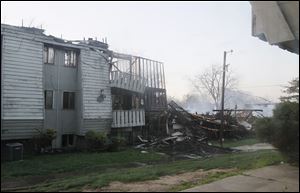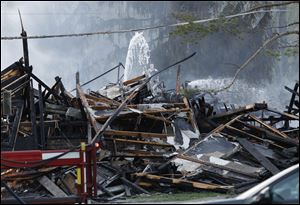
Arson blamed for deadly blaze at Springfield Twp. apartments
Complex's attic broke 1970s building code, lacked fire stops
4/3/2012
State and local fire and law enforcement officials are offering rewards for information leading to the person responsible for the Hidden Cedars Condominiums blaze, which killed two people and displaced 69 people.
THE BLADE
Buy This Image

State and local fire and law enforcement officials are offering rewards for information leading to the person responsible for the Hidden Cedars Condominiums blaze, which killed two people and displaced 69 people.
In the time it took Darrell Hicks to tie his shoes, fire had completely consumed the building next door.
"It was really quick," the 39-year-old resident of Hidden Cedars Condominiums said of the blaze that killed two people earlier this month at the Springfield Township complex on Garden Road.
Investigators with the state fire marshal's office ruled Monday that the deadly March 25 fire was the result of arson.
"Fire investigators have eliminated all accidental causes and have specific information and evidence that indicates the fire was intentionally set," Shane Cartmill, spokesman for Ohio Fire Marshal Larry Flowers, said in a statement Monday. "Because this is an ongoing criminal investigation, specific details including how and where the fire was ignited will not be released at this time."
It was the fourth fire to completely destroy a building at the complex in 12 years, but the first to result in death. The source of fires has varied -- teenagers smoking marijuana in the basement, an electrical hazard in a resident's living room, and arson.
But how each of those fires spread is consistent: quickly and through the attic.
Unlike buildings constructed today, the 70s-era buildings at Hidden Cedars -- five of which still stand -- have large, gaping attics. That massive space above individually divided units creates a dry, oxygen-filled pathway through which fires can spread rapidly without impediment. After all four fires at the complex, fire officials have lamented the lack of fire-stopping in the attics of the buildings, but they've always followed up those complaints by saying there's nothing that can be done about it. Structures are only required to meet the building standards in place at the time they are built, officials have said, and those standards were much less stringent in the early 1970s when Hidden Cedars was constructed.
But a Blade investigation has revealed a major flaw in that explanation.

The Hidden Cedars complex that burned March 25 had three stories and an attic larger than 10,000 square feet. Under the building code in effect when it was built, it should have had fire stops in its attic. It did not.
A review of the 1970 Ohio Building Code, which would have been in effect when Hidden Cedars was built in 1972, did in fact require fire-stopping in attic spaces that exceeded 3,000 square feet. Fire-stopping can take various forms, but is essentially a barrier intended to slow the spread of fire and compartmentalize its oxygen supply. It doesn't prevent fires, but it slows their spread, limiting damage and giving residents more time to escape.
The attic spaces in the 1970s-era buildings at Hidden Cedars are far larger than 3,000 square feet. The three story, 24-unit building that burned down last week had an attic larger than 10,000 square feet, and even the smallest of the remaining 1972 buildings have attic spaces larger than 5,000 square feet, based on an analysis of satellite imagery.
In short, the buildings appear to have been out of compliance with building safety standards ever since they began burning down 12 years ago.
Local officials said they learned of the fire-stopping requirement only after being informed by The Blade.
"I've always been told they didn't need fire-stopping," Springfield Township Fire Chief Barry Cousino said. "I was under the impression that was not a requirement of the fire code."
Even Bill Swade, who owned 11 units in the building that burned down earlier this month, said he was well aware that the buildings lacked fire-stopping. But like Mr. Cousino, he was under the impression that building codes didn't require such safety measures in the early 1970s.
When The Blade asked to examine the attics of the existing buildings, he refused.
"I really don't see why that's important," he said. "What difference is that going to make? What happened happened."
No stops cited

Springfield Township officials have ordered a four-foot-high fence to be built around the debris that remains from the fire. Right now, temporary tape surrounds the site.
Mr. Swade was less resistant to Chief Cousino, who, at The Blade's prompting, sent a crew to examine one of the remaining building's attics.
"It appears in that one building there are no stops," he said. He said he assumed the same was true of the other buildings, not including the two newer buildings at the complex that were constructed to replace those that burned down.
"I don't know why they were allowed to build those structures without a fire-stop," Chief Cousino said.
That responsibility would have fallen on the Lucas County Building Department. Chief Building Officer Phil Klocinski said he couldn't explain how building permits for the structures would have been approved without meeting building code requirements. His search for answers was complicated by another problem. The original building plans and approvals for the complex appear to have been destroyed, he said.
"I looked and searched and we don't have them," he said. "I talked to our records people, and once they are finalized, they basically get destroyed."
2 people died
The consequences of the apparent oversight are dizzying: millions of dollars in damage, scores of people left homeless, several residents injured, and, during the most recent inferno, two people dead.
Authorities have identified one victim as Robert McGhee, 61. Another male believed to be in his 50s has not been positively identified, but family members have said Olandia Keith Dixon, 58, was the second victim. The American Red Cross has assisted 30 adults and 39 children displaced by the blaze.
Chief Cousino didn't want to reveal too much about the arson investigation, but because of how the fire started, he said fire-stopping would not have saved those who died. However, it would have made a difference in the previous three fires, he said.
"Those fire-stops would have assisted us in keeping the fire from spreading within the building," he said.
'That's no excuse'
As mystifying as the initial approval of the building's construction is the failure of authorities to address the lack of fire-stopping after any of the previous three fires.
Chief Cousino said he was told by his predecessor that the building code in 1972 didn't require fire-stops.
"That's no excuse," he said. "I should have checked with the state myself."
But the state -- through the state fire marshal's office -- has investigated several of the fires at the complex, too.
Lyn Tolan, a spokesman for the state commerce department, which houses the fire marshal's office, said in an email to The Blade that the county building department would be responsible for enforcing code requirements.
"The Department of Commerce, through the Division of Fire Marshal and/or the Division of Industrial Compliance is not able to comment on the construction of a building which we have never seen and no longer exists," Ms. Tolan said.
Chief Cousino, meanwhile, said he is looking into what options are available to address the safety concerns at Hidden Cedars.
"That's absolutely part of my intent -- to find out legally what I'm capable of requiring," he said.
Ohio law allows fire chiefs to force owners to bring their properties up to code if there is an imminent threat to human life, he said.
"I'm not saying that chapter 100 percent gives me authority," he said. "I'm saying it's worth looking at."
88 units left
Until then, the residents of the five remaining older buildings on the property, which contain a total of 88 units, will continue to live under a cloud of uncertainty.
"My concern is the safety of me and my children," said resident Janika Clemmons, 34, who watched people leap from the balconies of the building that burned down last week. "I'm sort of on edge and nervous. With God's help, we'll be all right."
Investigators are asking for help in their arson investigation. The fire marshal's office is offering a "Blue Ribbon Arson Reward" of up to $5,000 for information leading to the identification of the person or persons responsible for the fire. An additional reward is being offered by Toledo/Lucas County Crime Stoppers. Anyone with information is asked to contact the Division of State Fire Marshal at 1-800-589-2728 or, for those who wish to remain anonymous, Crime Stoppers at 419-255-1111.
"Investigators want to hear from anyone who may have seen or heard something out of the ordinary at or around the time of the fire," Mr. Cartmill said. "Also, investigators want to hear from you if you have heard someone talking about the fire with an unusual level of interest or knowledge."
According to state law, a person who started the fire could be charged with murder -- even though he or she may not have intended to kill anyone.
Jacob Barnes, code enforcement officer for Springfield Township, said his office has issued an order to have the perimeter surrounding the debris from the fire secured with four-foot-high fence.
"It's totally unsafe situation right now with just that temporary tape," he said.
Staff writer Ignazio Messina contributed to this report.
Contact Tony Cook at: tcook@theblade.com, or 419-724-6065.